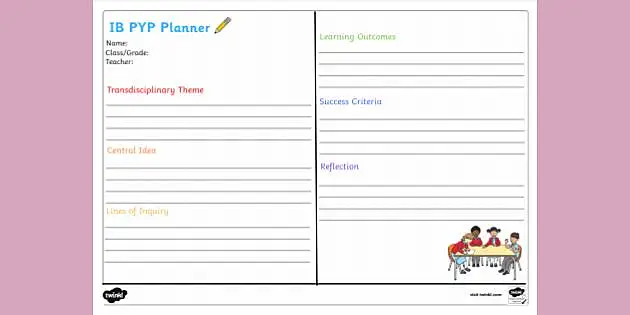- Welcome to BiblioGarden, your source for free PYP library lesson plans for the IB Primary Years Programme. Tested and developed over many years in many different international schools. Search by topic or theme.
- Customize this lesson planner for Google Slides and PowerPoint and stop worrying about forgetting important things!
- This lesson plan template was specifically designed around the 'Making the PYP Happen' for mathematics. Using this planning guide will ensure that inquiry based, constructive learning has been purposefully designed to support the learning and teaching of math in the PYP!
There are a number of different types of lesson plans and templates floating around out there. Here is a look at the most common ones:
* The 5 Step Lesson Plan


This lesson plan template was specifically designed around the 'Making the PYP Happen' for mathematics. Using this planning guide will ensure that inquiry based, constructive learning has been purposefully designed to support the learning and teaching of math in the PYP!
This is probably the version you learned to use at summer institute. I think it is the most straightforward lesson planning template and works for most topics and objectives. The 5 steps included in this version of the lesson plan are opening, intro to new material (“I do”), guided practice (“we do”), independent practice (“you do”), and the closing.
Here is an example 5 step lesson plan from Bunny Tucker: Bunny’s LP
Additional Resources:
* Blank 5 Step Lesson Plan Template
* Blank Lesson Plan Template from KIPP
* The 7 Step Lesson Plan
The 7 step template is similar to the 5 step lesson plan, but fleshes out the pieces of a quality LP a little more. The 7 steps are objective, motivation, intro to new material/directed lesson sequence, guided practice, independent practice, alternate and supplementary activities, and assessment. None of my corps members are currently using a 7 step template although if you read through their lesson plans they are implicitly including the parts of the 7 step LP. You can learn more about the 7 step LP and see an example in the Instructional Planning & Delivery institute text (pg. 28 & 29 in the toolkit).
* The 5 E Lesson Plan

The 5E model is best suited to inquiry-based instruction. The 5 steps lesson plan falls short in inquiry-based instruction because the “I do” occurs before the “you do”. It is often used in math & science classes when students are being asked to see patterns, understand concepts, or convey truths in the subject that are oversimplified when the teacher just “tells thems.” The 5 E’s are engage, explore, explain, elaborate, and evaluate.
Here is an example from Jarred Gibson, Teach For America’s Director of Math & Science Design:
Objective: SWBAT state that all living things are made of cells
Engage: A few days in advance, I’ll ask students what kinds of organisms they’d like to look at under the microscope. I’ll add to this list since they might not mention some interesting things. At the beginning of the lesson I’ll start by asking if they think they look like bacteria, blood, etc. Students will watch as I prepare one slide (onion root) to examine under the scope. I’ll have a few addl prepared slides (bacteria, frog muscle tissues, blood, other things students wanted to see). Then I’ll show students how to get cells from inside their cheek. Students will prepare slides on their own cheek cells.
Explore: Students will examine what’s under all the scopes and make drawings. They’ll have to identify what trends they’re noticin. Hopefully they’ll identify that everything is made of similar structures which look like round or rectangular boxes and that these structures often appear to have things inside of them.
Explain: Students read a short article about cells. We’ll discuss the reading and students lead students to explain that the structures they observed under the microscope were cells.
Elaborate: I’d present students with a piece of corks. I’d ask them if they thought it was living or not- most will say no. I’d say, well I’m not sure- scientists need evidence. How can we figure out whterh or not cork is living? Students will say that that we could look under the scope to see if cells are present. Students will prepare a final slide, this time of cork.
Evaluate: Students will look under the scope and see that the cork does indeed have cells and therefore must be alive. I’ll ask students to remember the other characteristics of living things they memorized earlier in the year (reproduces, grows and develops, obtains and uses energy, and responds to the environment) are in play here – is this cork truly alive? No, it’s not- it was alive at one point- it’s now dead and all we see are dead cells. But how did we know it was alive at one point? Because it was made of cells.
You can learn more about the 5 E model here: 5 E Model Executive Summary
Grace has been working to include more higher order thinking in her classroom and has use a modified version of the 5 E model to get her students to see the patterns in geometry. Grace did not label the engage, explore, explain, elaborate, and evaluate parts in her lesson plan, but if you read the content you will see that it does indeed follow the 5 E model. Check out her great work:
Pyp Lesson Plan Templates Google Docs
* Lesson Plan
* Class work
* Homework
Library Lesson Plans for the International Baccalaureate Primary Years Program
Designed and Delivered by an Experienced PYP Librarian
Search By PYP Transdisciplinary Themes:
Or Search by Additional Topics:
Welcome to BiblioGarden – Your Source for PYP Library Lesson Plans
BiblioGarden is your source for free PYP library lesson plans. This collection was developed specifically for librarians working within the International Baccalaureate (IB) Primary Years Program (PYP) framework. The lessons have been developed over many years, working in collaboration with teachers in many classrooms.
Something for Everyone
Whether you are a first time PYP librarian, or have been in a library for several years, I hope you will find value in these lesson plans. I have intentionally left off the grade level they were originally developed for, as I believe the content in these lessons is compatible across all grade levels.
In addition to the six transdisciplinary themes, I have included four additional topics. These are Back-to-School, Library Games, Special Events and Holidays, and Information Literacy. This should help you build a more comprehensive program to help meet the functional needs of your library, as well as fulfill the mission of the IB, “to develop inquiring, knowledgeable and caring young people who help to create a better and more peaceful world through intercultural understanding and respect.” (IBO.org)
Where to Begin?
The lessons are organized numerically, in the order suggested to be taught, by transdisciplinary theme. Currently there are approximately 120 lesson plans posted (135 written), but stay tuned as I continue to post lessons in Unit of Inquiry (UoI) blocks. By the end of May, 2018, all lesson plans for every UoI across Grades 1-5 should be complete.
Communicators Pyp
Have a question? You can learn more about me and my background here. Or, feel free to contact me directly, and I will do my best to answer your question, quickly and completely.
Thank you! Please use and adapt these lessons for your own students and school. It is my great pleasure and honor to share my work with you.
Pyp Book A Class
BiblioGarden | Free PYP Library Lesson Plans